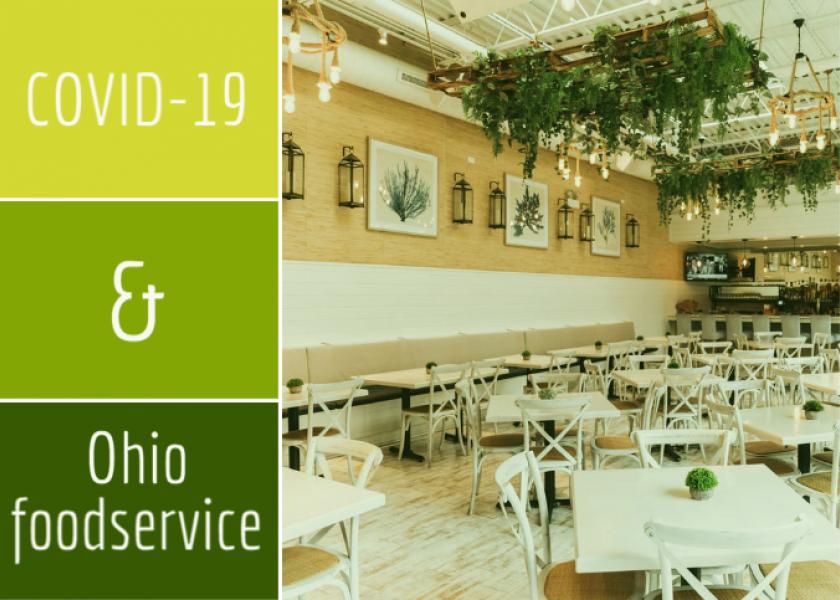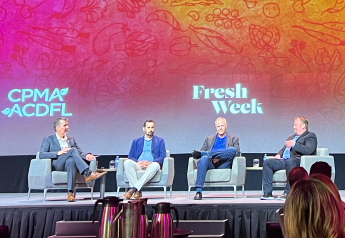COVID-19 closures take their toll on Ohio’s foodservice business

Highlights:
- Companies have been forced to adjust to the restirctions brought on by the pandemic, including resturants and school closures.
- A large majority of the Ohio foodservice sector (approx. 80%) won't break even this year.
- The pandemic already had forced about 3% of Ohio’s restaurants to close by the end of June.
- The U.S. Department of Agriculture’s Farmers to Families Food Box program has kept a number of Ohio suppliers busy.
For Ohio produce suppliers and their foodservice clients, things were going — and growing — smoothly through the winter months.
Then, as spring dawned, the new coronavirus COVID-19 swept across Ohio, as it also did the nation and the world.
“Pre-COVID, produce sales were continuing to grow, as well as many more varieties were being asked for from customers,” said Tom Sirna, president of Ravenna, Ohio-based wholesaler Sirna & Sons Produce.
“Ohio has a rich, diverse population filled with casual dining, mass feeding and independent chef-driven concepts throughout the state. There is something for every diner to choose from. Through March of 2020, it was vibrant, growing, and ever-changing.”
But COVID-19 changed everything for the worse, with little or no advanced notice, Sirna said.
Everything froze. Restaurants shut down. Diners flooded grocery stores and stocked up. And produce wholesalers who had relied on foodservice sales saw that end of the business suddenly wither.
“With the COVID virus, foodservice came to a screeching halt and is still attempting to rebound from the economic damage that it has caused,” Sirna said.
“While independent restaurants always look to explore new products and create fresher dishes with many ingredients, many multi-unit restaurants also continue to put different fruits and vegetables on their menu.”
While Ohioans struggle to stay healthy amid the pandemic, produce suppliers say they’re wrestling with new ways to keep their businesses breathing.
Wholesalers who deal heavily in the foodservice sector are particularly susceptible to economic maladies, said Alex DiNovo, president and COO of Columbus, Ohio-based distributor DNO Produce, whose business is about 85% foodservice, including schools.
Related: DNO Produce adds cooler space to distribution center
DNO has adjusted to the restrictions brought on by the pandemic, including restaurant and school closures, DiNovo said.
“You’d think this would be a huge negative, but we’ve seen a lot of schools doing a lot of grab and go, which we do well,” he said.
By the end of June, DNO actually had managed to stay “a little ahead of budget for the year,” DiNovo said.
“We’re doing a lot of high-demand, grab and go, ready to eat, fresh-cut items,” he said.
Others who rely on foodservice sales may not be so fortunate, DiNovo said.
“I’m hearing a lot of these guys initially, they were down to 20% to 30% of revenue; now, I’m hearing 75%,” he said.
“If you specialize in restaurant sales, first they were shut down for two months and now they’re operating at half capacity. There’s going to be restaurants going out of business and distributors will go along with them. I hope that’s not the case.”
Caught off guard
The pandemic caught Dayton, Ohio-based foodservice supplier Produce One by surprise, said Erv Pavlofsky, principal of business development.
“When we learned in mid-March on a Sunday that the restaurants were going to close at 8 o’clock that evening, it caught us off guard,” he said.
“The universities and K-12s were already closed, so we didn’t have that big an adjustment, but when restaurants closed, we were in scramble mode — work with retail outlets, local communities and food banks and did everything we could not only to support our communities but to get rid of the inventories we already had on hand. Then, after a couple of weeks, restaurants opened for carryout, and we worked very close with customers on to-go menus and actually had cut back our delivery services from six to four days a week.”
Many of ProduceOne’s fine-dining clients did not reopen until around June 1, Pavlofsky said.
“We worked with all our customers throughout,” he said.
Related: Buurma Farms upgrades equipment, adds partner
COVID-19 has wrought “unprecedented” damage to the foodservice sector, said Homa Moheimani, director of communications with the Columbus-based Ohio Restaurant Association.
“It has been a really challenging time for restaurants,” she said. “First, half of the restaurants in Ohio were closed at one point — zero traffic without drive-through, pickup,” she said.
Some of Ohio’s “best-performing” restaurants were operating at 50% capacity, Moheimani said, noting that the association has been doing weekly surveys of Ohio’s foodservice sector since the pandemic first broke out in March.
The results are less than encouraging, she said.
“I’d say near 80% won’t break even for 2020,” she said.
The long-term implications are painful too, Moheimani said.
“Every week, another location closes or is selling the business if they can; that means less restaurants and independent owners/operators,” she said.
“They want to serve their guests, but ultimately, most of the closings are for financial reasons. If the traffic isn’t there, it’s just not sustainable.”
That’s not good for produce suppliers, Moheimani said.
“The food supply chain was a total wreck,” she said. “The stores were overwhelmed, and food wasn’t being purchased by restaurants. Dairy farmers had to get rid of the milk. One reason that happened is restaurants are an integral part of the food supply.”
Moheimani noted that more than half of the money spent on food in America is typically spent in restaurants.
“Take that away, and it completely changes everything,” she said.
Some restaurants across Ohio have adjusted with the restrictions imposed on them, Moheimani said.
“There are ways owners are trying to be creative, selling bulk produce and items — even toilet paper — because they have access to those supplies,” she said.
“Some have meal kits, where they give you all the produce and you can make it at home. That’s actually going to continue to happen — almost like a storefront. We’re hoping that as restaurants continue to open, that kind of balances that out.”
Related: Ohio suppliers ready for heavy retail sales this season
Changing models
For restaurants that have reopened or somehow continued to operate, things have changed in terms of how diners can procure fruits and vegetables, Moheimani said.
She said, for example, the rules around salad bars and buffets have changed.
“In Ohio, there’s been several guidelines and mandates; it’s up to the business location how they go about this,” she said.
Salad bars, as diners have come to know them, probably are things of the past, Pavlofsky said.
“I think there will be salad bars, but there will be somebody making them for you,” he said. “I don’t think you’re going to be able to put your hands in food anymore. That’s just my opinion, but I think anything that will be self-serve will be all packaged.”
The Ohio-based Amish buffet-focused Der Dutchman restaurants have had to adjust, as guests no longer can serve themselves, Moheimani said.
“Because guests are not permitted to serve themselves, they continue to offer buffets but with staff,” she said. “That certainly impacted a lot of places. Some may have changed their model completely and others may still offer buffets but offer it within the guidelines.”
Social-distancing and seating-capacity limitations have affected restaurants’ business, which usually generates more than $25 billion in annual sales at more than 23,000 locations, Moheimani said.
“Obviously, that has changed pretty drastically,” she said. “If you can imagine 50% of 23,000 locations closed, that’s a huge hit.”
The pandemic already had forced about 3% of Ohio’s restaurants to close by the end of June, Moheimani said.
“We don’t know how this is going to end,” she said.
Produce suppliers said they had endured a tough stretch.
“It’s not going swimmingly,” said Jamie Sanfillipo, partner with Columbus-based Sanfillipo Produce Co. Inc.
“When you’re in the foodservice side of things, and there’s nobody having parties, weddings or anything like that, it’s obviously going to hurt business. If you’re a grocery store supplier, you should have made a fortune this year. Our bread and butter are restaurants. As long it’s only allowing a third of the people in, it’s going to affect business.”
Sanfillipo Produce has had to “work a little smarter” to compensate for the loss in foodservice sales, Sanfillipo said.
Related: Ohio businesses rise to meet COVID-19’s challenges
“We’re focused on doing little things here and there,” he said. “I’m running some freight for a company in California to a warehouse in Ohio. I’ve picked up on whatever we can to make money that has normally nothing to do what we normally do. I’m not saying no to a lot of things.”
The company has eked out a profit, Sanfillipo said.
“We’re still profitable, just not close to where we were last year,” he said. “I know there’s a lot of people who’s lost a ton of money, but we’re just small enough we can control things.”
USDA steps in
The U.S. Department of Agriculture’s Farmers to Families Food Box program has kept a number of Ohio suppliers busy.
Through this program, USDA is working with national, regional and local suppliers, whose workforces have been significantly affected by the foodservice closures to buy up to $3 billion in fresh produce, dairy and meat products. It supplies boxes packaged with fresh fruits and vegetables, dairy products, meat products and a combination box of fresh produce, dairy or meat products.
Suppliers ship family-sized boxes to food banks, community and faith-based organizations, and other nonprofits.
The opening round of purchases, worth as much as $1.2 billion, ran May 15-June 30. The second round, July 1-Aug. 31, aims to purchase up to $1.47 billion.
“I thought the whole program was a joke, the way it was administered,” Sanfillipo said.
“If they wanted it to work for everybody, they should have looked at the local and regional distributors. It’s designed to help the gigantic farms and very large distributors. The people on the ground every day trying to make a living are the ones that suffered.”
ProduceOne has participated in the box program, Pavlofsky said.
“The program has been very successful at getting product into people’s hands, getting fresh fruits and vegetables to people in need,” he said. “It’s been extremely rewarding for our company to be a part of that.”
Alex Buck, president of the Fruit Growers Marketing Association in Newcomerstown, Ohio, said foodservice was “working at approximately 40%,” compared to the same period a year ago.
“We have offered payment programs to our foodservice customers to help them through the rest of the year,” Buck said. “Unfortunately, no one knows when they will be back to 100%, but we will be by their side along the way.”
Foodservice business seemed show “a nice increase” in June, Pavlofsky said.
“Where some of our biggest challenges have been is in some downtown office buildings, which have not been reopened,” he said.
“It’s forced us to look at other opportunities. One of them have been K-12s that have been doing feeding programs. So we’ve been doing a lot of schools over the summer, which normally wouldn’t be doing much.”
Suppliers still were looking for an end to the foodservice crisis at the end of June, Sirna said.
“At this point, it is very hard to tell what the future will look like,” he said.
“Many hotels are not even open, or if they are, they are running at 10-20% occupancy. The consensus nationwide is there is a high rate of independent restaurants that will not be able to re-open, as well.”







